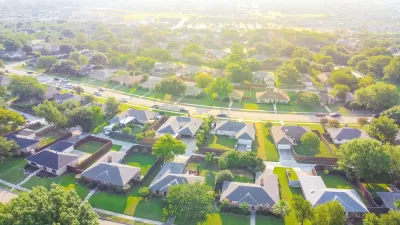Labels like "YIMBY" and "NIMBY" may be crude—but so what? One of them wants to solve America's housing crises. The other does not. Un-housed and under-housed people cannot wait for a perfect ideology to come along, writes Josh Stephens.

I don't like to give too much credence to random outbursts from the Twitterverse, but a recent thread has stuck with me. Among all the debates over and epithets that have been hurled around California's housing crisis, perhaps the most outlandish claim yet is that it is dull.
This is the analysis not of a dour teenager or jaded NUMTOT but rather of Kian Goh, a professor of architecture and urban planning at UCLA and author of a book, Form and Flow: The Spatial Politics of Urban Resilience and Climate Justice, about grassroots responses to cities’ climate change strategies. Shortly after the passage of SB 9 and SB 10—two laws that seek to increase production of market-rate housing—she weighed in to remind celebrants and mourners alike that "NIMBY/YIMBY is a barren framing. Or at least... an uninteresting one."
Cue Steve Martin.
Goh elaborated: "NIMBY/YIMBY doesn't help us understand power relationships on the ground well (why disparate groups might be against similar policies), doesn't illuminate histories of place (why struggles to protect people and places are not all the same)..."
What the professor is basically saying is that reality is more complex than slogans. Of course it is. But, to call out shortcomings, rather than to "do the work" (to quote a popular academic and activist phrase) to appreciate the subtleties of YIMBY advocacy and even NIMBY (dis-)advocacy, seems to me barren in its own right.
In point of fact, the rise of YIMBYism has always has been about power relationships. For generations, mostly white homeowners have dominated California land use politics. They were in favor of growth as long as it suited them (up to the late 1970s), and then, once they realized that poeple of other races were living out the American dream, they decided to oppose growth (Manuel Pastor convincingly describes this shift in State of Resistance). They've spent the past four decades building up organizations and grooming public officials to support their positions and listen ever-so-earnestly to their concerns.
YIMBYs surely have their shortcomings too. Maybe they are also too white, too male, and too upwardly mobile. But they arose explicitly to provide a counterweight to those exceedingly powerful entrenched forces.
Goh continues: "This framing doesn't help us see the most intractable problems facing cities right now, why it's so hard to do big, great things.... and generally does not especially inspire wildly imaginative ideas about new, transformative, socially just and radically environmental ways of living in the city."
In other words: neither NIMBYism nor YIMBYism can perform miracles, so let's just call off the whole thing.
First, let's be clear that, in a trend that mirrors national party politics, one half of this binary has exactly zero interest in anything "new" or "big." NIMBYism may occasionally invoke social justice and environmentalism, but usually in narrow, and usually to argue against development of new housing. As for "transformative": that's the exact opposite of what the opponents of development want. If we are looking for any of those things, it's not the "framing" that should upset us.
I'm not sure how much imagination we really need. YIMBYism is based on the totally unimaginative premise that the number of bedrooms in a given geography should relate roughly to the number of humans who would like to live there.
If you ask me, some of the most active imaginations belong to people who oppose new housing—for the variety and inanity of their justifications. They claim that housing threatens the tree canopy. They claim there’s some conspiracy to keep units vacant. They propose to ship Los Angeles's unhoused people to camps in the high desert. (I really wish I was kidding about that one.)
Meanwhile, look at the astonishing diversity of designs, theories, articles, and books that have arisen in response to California's housing crisis. In Los Angeles alone, we have the "Low-Rise Design Challenge;" UCLA's CityLab; the nonprofit advocacy group LA Más; and architect Gerhard Meyer's tireless promotion of an "international building exhibition"—to name just a few.
Sure, "transformative" things will remain hard, and debate will remain even tedious. But you know what's more tedious? Spending $2,000 on rent when you make minimum wage. So, I'm glad people are willing to put themselves out there and fight even for small victories. (Some of these people are colleagues of hers who, admirably, stick their necks out to advocate for policies that build on their research.)
Back on Twitter, a few folks—resoundingly perturbed—commented on Goh’s post.
Their comments include, "things can be intellectually barren and yet practically quite terribly relevant;" "it seems like they clearly offer different visions of the world, one that makes housing more affordable and welcomes diversity, and one that hoards, excludes, and exacerbates segregation;” and "What alternative framing do you propose...?" I chipped in with, "Which 'wildly imaginative ideas' do you consider politically, financially, and pragmatically feasible?"
Goh is a professor in two renowned departments at a major university with a Twitter following of over 7,300. She's written books and articles and contributed to projects around the country. Literally nothing is stopping her from showing the world how imaginative we can be.
Her response to these comments? Not a tweet to be heard.
I don’t want to lay all the sins of housing obstruction at the feet of a single academic. But, Goh’s tweets seem emblematic of the entire NIMBY project: to seek a Utopia while complaining so stridently about the status quo that no one has the energy to discuss anything productive. If we're going to solve America's housing crisis, everyone—professors and activists alike—need to be less imaginative, less combative, and a lot more collaborative.

Planetizen Federal Action Tracker
A weekly monitor of how Trump’s orders and actions are impacting planners and planning in America.

Maui's Vacation Rental Debate Turns Ugly
Verbal attacks, misinformation campaigns and fistfights plague a high-stakes debate to convert thousands of vacation rentals into long-term housing.

Restaurant Patios Were a Pandemic Win — Why Were They so Hard to Keep?
Social distancing requirements and changes in travel patterns prompted cities to pilot new uses for street and sidewalk space. Then it got complicated.

In California Battle of Housing vs. Environment, Housing Just Won
A new state law significantly limits the power of CEQA, an environmental review law that served as a powerful tool for blocking new development.

Boulder Eliminates Parking Minimums Citywide
Officials estimate the cost of building a single underground parking space at up to $100,000.

Orange County, Florida Adopts Largest US “Sprawl Repair” Code
The ‘Orange Code’ seeks to rectify decades of sprawl-inducing, car-oriented development.
Urban Design for Planners 1: Software Tools
This six-course series explores essential urban design concepts using open source software and equips planners with the tools they need to participate fully in the urban design process.
Planning for Universal Design
Learn the tools for implementing Universal Design in planning regulations.
Heyer Gruel & Associates PA
JM Goldson LLC
Custer County Colorado
City of Camden Redevelopment Agency
City of Astoria
Transportation Research & Education Center (TREC) at Portland State University
Jefferson Parish Government
Camden Redevelopment Agency
City of Claremont






























